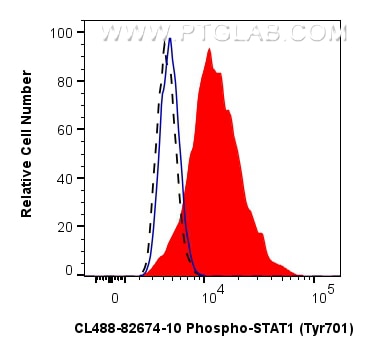Anticorps Recombinant de lapin anti-Phospho-STAT1 (Tyr701)
Phospho-STAT1 (Tyr701) Recombinant Antibody for FC (Intra)
Hôte / Isotype
Lapin / IgG
Réactivité testée
Humain
Applications
FC (Intra)
Conjugaison
CoraLite® Plus 488 Fluorescent Dye
CloneNo.
1C5
N° de cat : CL488-82674-10
Synonymes
Galerie de données de validation
Applications testées
| Résultats positifs en FC (Intra) | IFN gamma treated THP-1 cells, |
Dilution recommandée
| Application | Dilution |
|---|---|
| Flow Cytometry (FC) (INTRA) | FC (INTRA) : 0.25 ug per 10^6 cells in a 100 µl suspension |
| It is recommended that this reagent should be titrated in each testing system to obtain optimal results. | |
| Sample-dependent, check data in validation data gallery | |
Informations sur le produit
CL488-82674-10 cible Phospho-STAT1 (Tyr701) dans les applications de FC (Intra) et montre une réactivité avec des échantillons Humain
| Réactivité | Humain |
| Hôte / Isotype | Lapin / IgG |
| Clonalité | Recombinant |
| Type | Anticorps |
| Immunogène | Peptide |
| Nom complet | signal transducer and activator of transcription 1, 91kDa |
| Masse moléculaire calculée | 83 kDa |
| Poids moléculaire observé | 84-91 kDa |
| Numéro d’acquisition GenBank | BC002704 |
| Symbole du gène | STAT1 |
| Identification du gène (NCBI) | 6772 |
| Conjugaison | CoraLite® Plus 488 Fluorescent Dye |
| Excitation/Emission maxima wavelengths | 493 nm / 522 nm |
| Forme | Liquide |
| Méthode de purification | Purification par protéine A |
| Tampon de stockage | PBS with 50% glycerol, 0.05% Proclin300, 0.5% BSA |
| Conditions de stockage | Stocker à -20 °C. Éviter toute exposition à la lumière. Stable pendant un an après l'expédition. L'aliquotage n'est pas nécessaire pour le stockage à -20oC Les 20ul contiennent 0,1% de BSA. |
Informations générales
STAT1 (signal transducers and activators of transcription 1) is a member of the STAT protein family. STAT family members are phosphorylated by the receptor associated kinases, and then form homo-or heterodimers that translocate to the cell nucleus where they act as transcription activators. The phosphorylation of STAT1 at Tyr701 promotes the dimerization of STAT1 and its translocation into the nucleus where it binds the GAS promoter to allow the transcription of inflammatory response genes(PMID: 31408005). The transcript of STAT1 undergoes alternative splicing, resulting in two isoforms: STAT1α (91 kDa) and STAT1β (84 kDa)(PMID: 20159032).


